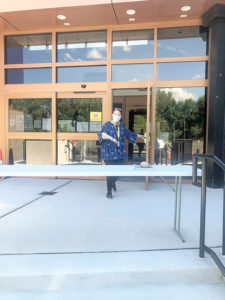By Eli Rallo
The coronavirus pandemic has affected every industry, business and organization in incommensurable ways. One of these industries is the reading, library and bookstore industry. Despite not being able to physically browse and shop for a period of time, books have been in high demand throughout the duration of the pandemic.

At the Monmouth County Library’s Eastern Branch in Shrewsbury, librarians fill book requests from readers during curbside pickup hours. The branch is also now open at cer- tain times for in-person browsing with safety guidelines.
Even though many customers shop for books from national businesses with online ordering and shipping capabilities such as Amazon and Barnes and Noble, in the Two River area residents are lucky to have a selection of places where they can shop for or borrow reading materials. With the Monmouth County Library system, Red Bank Library and Fair Haven’s River Road Books, the opportunities to support local businesses in order to read are endless.
All New Jersey libraries and bookstores were closed March 20 when Gov. Phil Murphy issued Executive Order 107. “RBPL acted a bit proactively,” said Eleni Glykis, the library director at Red Bank Public Library, canceling all in-person programming March 12, closing entirely to the public March 13, and sending staff home March 19. “While we were closed to the public, we offered digital library cards and story-times,” she said. “Our staff created materials to promote our digital services, we set up remote desktop connections to computers we needed, set up a Zoom account, and went completely digital with all of our programming. We put up notices on our website and worked with our consortium, Libraries of Middlesex Automation Consortium, to extend checked out material due dates, library card expiration dates and assist us with disseminating information to the public. We also worked with our wonderful public school system to share information on what the library was doing during our physical location’s closure.”
Red Bank Public Library’s quick thinking allowed it to continue helping clients and even expand its business. “We’ve seen a dramatic increase in the usage of our digital resources, library card sign-ups, as well as community engagement through our social media pages,” Glykis said. “By the end of May, we had 28,000 views of our website, and we totaled just 60,000 the entire year prior. Some of our digital resources have seen as much as a 114 percent increase in usage. Additionally, we have seen tremendous increases in some program participation.”
Anyone could surmise that members of the community flocked to libraries and bookstore websites for something to do throughout the duration of quarantine, when Netflix has been exhausted.
Libraries and bookstores recognized a community need for books and other reading materials, and began working with contactless curbside pickup, online ordering and other innovations when the pandemic prohibited visitors.
“We started a staff blog to provide additional information and entertainment for our community,” said Glykis. “We’re developing new programming during the quarantine, such as ‘Let’s Talk about Change,’ a young adult-oriented program aimed at having discussions on various tough topics.” The library has a Race and Diversity Storytime, spearheaded by Sira Williams, children’s librarian, and the summer reading program for the first time is entirely online. “We have also offered our staple programs, such as our award-winning Let’s Talk About Race, which had over 70 participants recent- ly,” Glykis said.
Though operations are certainly not “normal,” libraries are doing the best they can to replicate pre-pandemic operations, and foster a sense of community even with social distancing guidelines.
“Many patrons used to spend the day with us, attending concerts, movies, lectures and book clubs, even playing bridge,” said Kim Avagliano, chief librarian at Monmouth County Library Eastern Branch in Shrewsbury, one of the largest libraries in the county system. “In-person meetings and programs will not occur during the next phase of reopening, again to be consistent with the governor’s executive order. However, the core work of the library remains the same: matching patrons with the next book they want to read and helping them find the information that they need, which could be everything from finding phone numbers to ratings on consumer goods, financial information to genealogy research, educational needs to resources for personal development, recreation and leisure.”
The Monmouth County Library did see an increase in some book loans due to the pandemic. “We saw the circulation of our eBooks increase nearly 60 percent over the same period last year, lending almost 165,000 titles during the closure,” Avagliano said, “We added over 350 brand new library card holders in that time period, and nearly 200 people who had not used the library for a while came back and renewed their cards to access the many resources and services we offer.”
Libraries can not only foster a love of reading, provide educational resources and serve as an activity, but also create community and harmony within towns and cities. The local librarians appear to remain positive and upbeat, despite the obvious challenges. And though business operations have been upended, the pandemic has given libraries a bit of a boost: When people were out of work, school and social activities, many turned to books.
When many libraries reopened July 15 – with social distancing guidelines and mask-wearing rules in place, consistent with the governor’s Executive Order – the number of patrons indoors was limited to 25 percent capacity, a rule Karen Rummage and Laurie Potter also need to comply with at their store, River Road Books in Fair Haven. Throughout the pandemic they provided online ordering with curbside pickup for customers and noted community members have lately been looking for books about social activism and recent events in the nation.
“People are hungry for a diversion,” said Potter. “Books and puzzles have provided that these past few months. We have also seen a big uptick in books about black history and racism for both children and adults.”
This sentiment was echoed by Glykis of the Red Bank Public Library. “We saw the real drive for anti-racist books following the protests across the U.S. in reaction to the death of George Floyd and demands for justice for Breonna Taylor.”
“Reading connects us to one another, reading helps us create empathy and gain perspective,” she said. “I think especially with these issues, people turned to books for that, especially when connecting with one another was mostly through a screen. Something gets lost in that type of connection, but reading creates a real connection between the words of the author and the reader in the way a Facetime or a text cannot.”
The article originally appeared in the July 16 – 22, 2020 print edition of The Two River Times.














